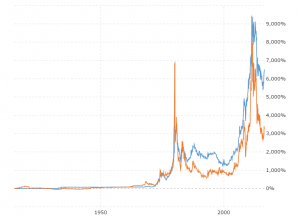Liberty on American Coins
There is without doubt one enduring symbol on American coins – Liberty. This founding principle of the Union has a long history personified as a woman, going back to the ancient Romans, who depicted the principle of freedom as a woman, Libertas. In 1793, at the height of the French Revolution, Notre Dame Cathedral in Paris was briefly the ‘Temple of Reason’, and pictures of the Virgin Mary were replaced by the Goddess of Liberty. The famous painting from 1830 of ‘Liberty leading the People’, by Delacroix, showing a bare-breasted young woman carrying the French flag and leading the revolutionaries in battle, became the enduring character Marianne, in France, an image that persists today in the country of Liberté.
In American the images were less flamboyant, but Liberty as a woman quickly found her way onto the American dollar. Two versions appear on the earliest dollar coins – one with long hair, called the Flowing Hair dollar, was minted in 1794 and 1795, soon followed by the Draped Bust dollar, from 1795 to 804. Then, as in the 1960s, long, flowing hair, free of restraint, was a potent symbol of liberty.
Minting of silver dollars stopped in 1806, and didn’t resume until 1836, by which time Lady Liberty had taken a seat, assured of her dominance in the new Republic. The Seated Liberty dollar, with Liberty sitting on a rock, holding a shield (to become the Union Shield) bearing the word ‘Liberty’, and carrying in her left-hand a stick with a Phrygian cap on it. That cap, a symbol of freed slaves from antiquity, was another potent symbol of Liberty, and became the bonnet rouge of the French Revolution. It’s use in American was not without controversy, since during the slave era slave-owners were concerned that its use could be confused with Emancipation.
Seated Liberty rested until 1873, to be replaced by a bust of Liberty on the Morgan Dollar. This coin was minted until 1921 (not continuously), and is the second most popular collector coin, in all its variations, to the Lincoln cent. Since it is only a bust, it is not clear what Lady Liberty is doing, but by 1916, in a changing world with war in Europe and Asia, she has taken to her feet, as seen on the Walking Liberty half-dollar, issued between 1916 and 1947 – times of tribulation, revolution and conflict across the planet. Liberty did indeed need to stride out and take action.
There is a certain irony in the fact that Adolph A. Weinman, the designer of Walking Liberty, was a German, at a time when America was torn between simply funding and taking an active part in the war against Germany raging in Europe. Of course, Weinman had arrived in America when he was just 14, in 1884, so he was just one of the large numbers of German immigrants in America in those years. In his design Lady Liberty, wearing a Phrygian cap, strides toward a rising sun – symbol of hope for a better future – carrying a large bouquet of laurel and oak branches, symbols of glory in both the military and civil spheres. The reverse shows an American Eagle, about to take off, with all his power, from a rocky vantage point. From a crack in the rock emerges a seedling pine tree, symbolic of endurance and persistence. It would be hard to find a more intense image of the conflict raging in America at the time over sending soldiers to fight in Europe.
The Walking Liberty half-dollar continued to be minted until 1947, and the symbolism must have served a useful purpose in the 1940s too, in drawing America into the second global conflict to engulf the world just 20 years after the first ended.








